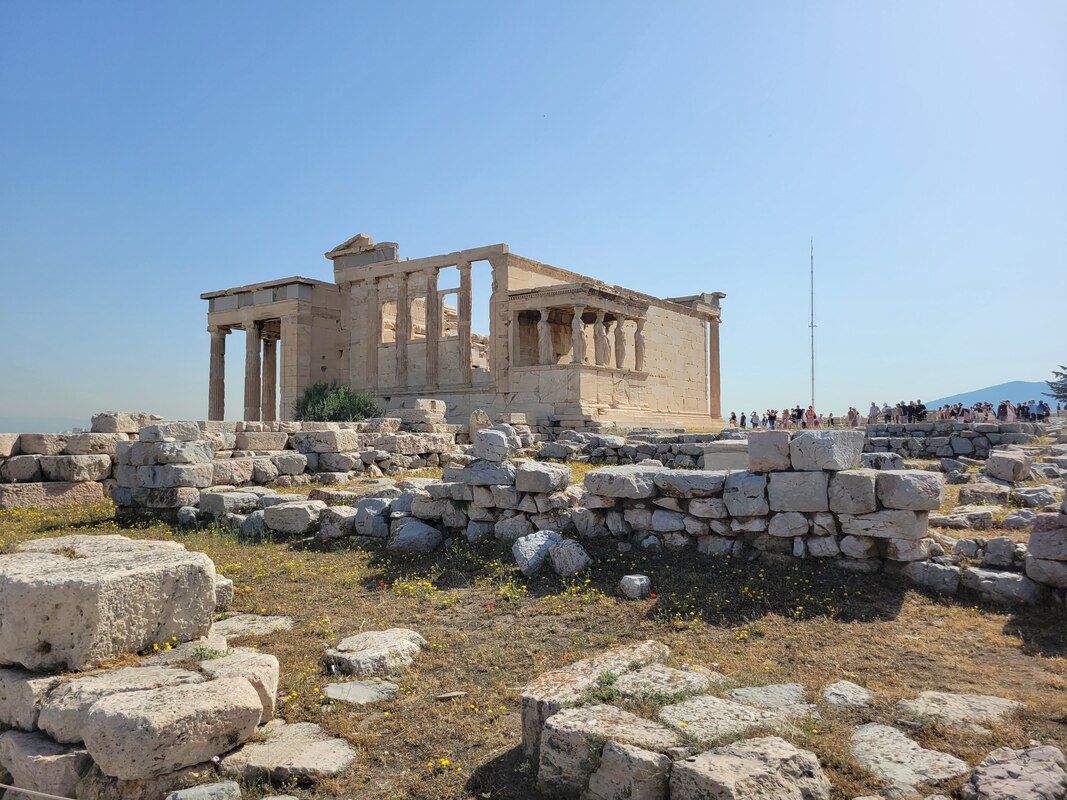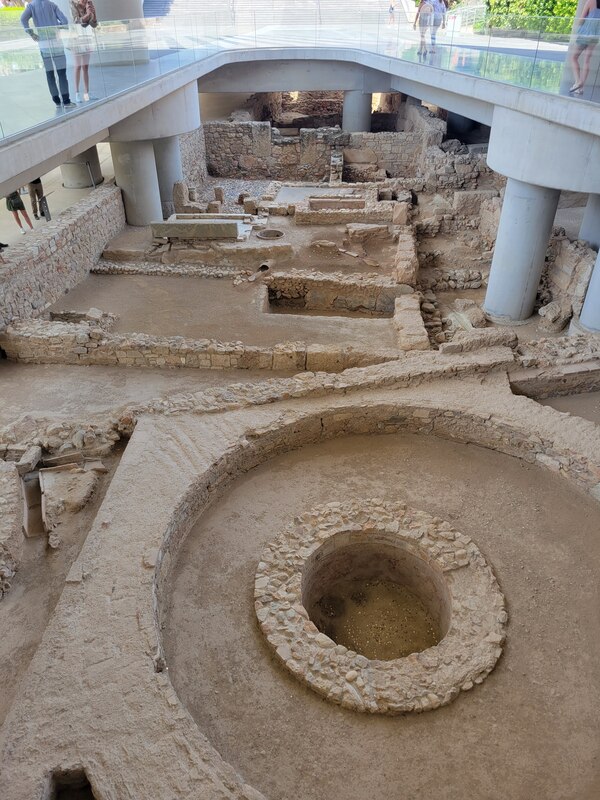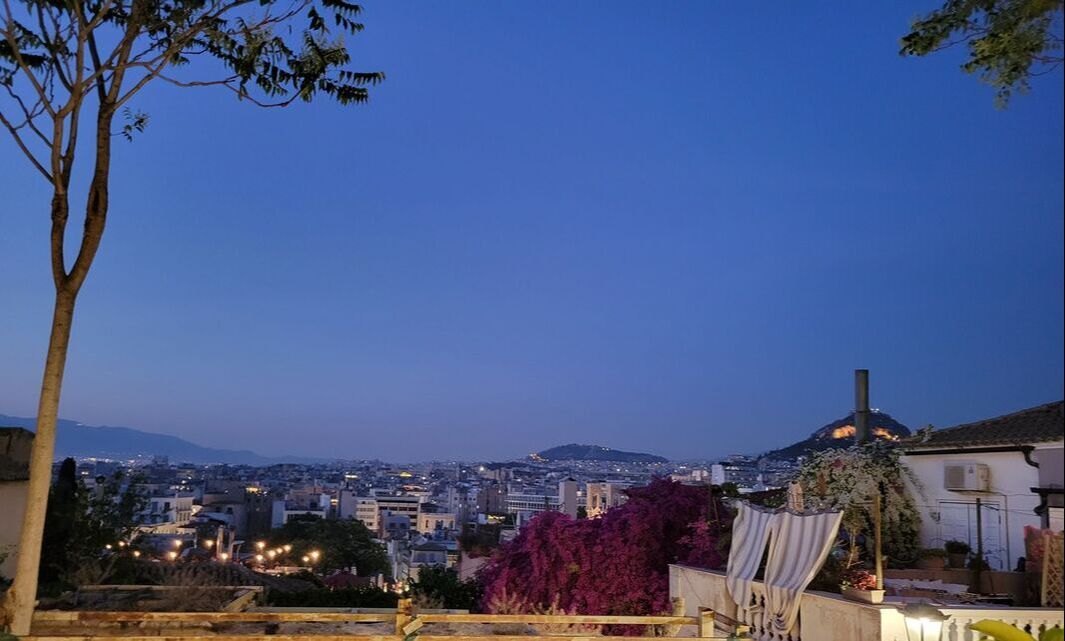Ancient Athens: The AcropolisDay 2 started bright & early with a tour of the Acropolis first thing. The Acropolis is one of the biggest tourist attractions in Athens, so it can get very full, which is why we were there right around opening time to be one of the first groups allowed on-site. After walking a few blocks from our hotel, we met up with our tour guide, Mamma Fay. The Acropolis is really up on a huge hill in the middle of Athens (Acropolis means "high city"), so we did have quite a hike up to the top (sometimes on concrete, sometimes on gravelly paths), but Mamma Fay gave us lots of rests (in the shade when possible) while she talked about the site, renovations, and ancient Greek civilization.
|
On our way up the hill, we were able to admire the Odeon of Herodes Atticus (an amphitheater still used for performances today), and the impressive Propylaea gates to the Acropolis (no, this isn't the main event just yet!). The Propylaea is immense and in all its gleaming white marble, certainly hard to imagine painted in bright colors! In fact, most of the ancient Greek and Roman sculpture and architecture we see and know today was often painted in bright colors, not just pristine white! But a lot of the paint faded or was ignored by Renaissance artists who brought back the classical style in all-white. The Propylaea also once had a roof, which Mamma Fay says some visitors find hard to believe - but no one wanted to walk in the rain or beating sun even in ancient Greece!
Once you come through the Propylaea, you get your first glimpse of the Parthenon (not to be confused with the Pantheon in Rome!). The temple dedicated to the goddess Athena (guess who Athens is named after?) is enormous and seemingly forever under ongoing restoration projects behind lots of scaffolding. While Greece was under control of the Ottoman Empire, they Ottomans used the Parthenon as an armory where they stored weapons and gunpowder. In a campaign to conquer the Peloponnesian peninsula (the heart of this tour) during the Morean War in 1687. the Venetians attacked Athens in 1687 and laid siege to the Acropolis. When a shell struck the Acropolis, the gunpowder stored there set off a large detonation that blew the roof off the Parthenon and damaged much of the building and artwork. This also led to further deterioration over the years, so the ongoing restoration is aimed at piecing together the various parts found at the site and restoring and preserving what is possible. It was incredible to think about (and see!) the efforts to still put together the columns and stonework hundreds of years later! I especially appreciated all the different equipment to raise and move the stones. The government has also set up info boards around the site about the work (and the expense!) surrounding restoration.
|
But the Parthenon is also an impressive feat of engineering and construction in itself. Although the building looks to be all imposing pillars and straight lines of solid stone, it's a little deceptive. To give the appearance of straight lines, the builders actually used curves to make it look that way (ironic, no?). If the temple had been constructed with only straight lines, the building would have appeared like it was lifting up at the edges and that the columns were leaning away from each other. So, instead, the architects planned for the base of the Parthenon to curve up slightly in the middle, and the columns actually lean inwards toward each other to create the optical illusion of balance and straight lines. The columns are also thicker at their base and get smaller as they go up to create the illusion that they are the same width to us tiny humans standing on the ground. They are also constructed of drums stacked around iron pins. It is incredible to think that the Greeks developed these techniques and had such an understanding of visuals almost 2500 years ago!
|
One of the other incredible site at the Acropolis is the Erechtheion (say that 10 times, fast!), or the Temple of Athena Polias. The Erechtheion has some of the oldest origins on the Acropolis, built on the ruins of a Mycenean temple. The gem of the Erechtheion are the Caryatids - the six beautiful female statues supporting a porch roof facing the Parthenon, as seen in the header photo above. These sculptures take the place of columns and are named after the maidens of Karyai, a town on the Peloponnese near Sparta.
|
In the shade of the Erechtheion rests an olive tree - not the olive tree, but one has been planted here traditionally for thousands of years in keeping with the legend of the first olive tree planted by Athena. In a competition to become patron of the city (and for naming rights?), Poseidon and Athena each gave gifts to the city. You can probably guess who won the contest given the city's name, but Athena planted an olive tree on the Acropolis and won.
The Acropolis sits high above the city, and also offers views of what feels like most of the country. In actuality, you can see about half of the Greek population from the Acropolis since Athens is one of the most densely populated cities in the country.
|
It's all Greek to me!
|
After exploring the Acropolis site, Mamma Fay took us on a tour of the Acropolis Museum. The museum was custom-built in the early 2000s to showcase and house the treasures of the Acropolis. The top levels of the museum sit askew to mirror the angles and measurements of the Parthenon, while its foundation aligns with ancient foundations below. While you can see some copies at the Acropolis site, most of their originals are housed within the Acropolis Museum, including the six Caryatids. The top floor which mirrors the Parthenon are build to house the Parthenon marbles and friezes. Unfortunately, most of what is currently housed on this floor are incomplete and damaged fragments, but the Athenians hope to one day house the more complete set of Parthenon sculptures currently in Britain's London Museum after they were taken by Lord Elgin (sometimes referred to as the "Elgin Marbles").
|
Following our morning tours, we had the rest of the day free to explore more of the museum and for lunch and dinner. The Acropolis Museum is built on ancient foundations dating back to 3,500 to 3,000 BC, some of which you can see through the glass floors of the museum, but the site is also partially accessible under the museum, which we explored after a delicious lunch at the museum restaurant. Fair warning, the service is not particularly prompt at the museum restaurant, so we often dined with pigeons at the next table if it wasn't cleaned quickly. But the view of the Acropolis can't be beat!
|
Since the hotel was so close to the museum, I ended up going back to the hotel for some cold water and a recharge. After relaxing, I headed out to find some dinner and ran into another tour member. We decided to find Xenios Zeus in the shadow of the Acropolis for our evening meal, although it turned out to be harder to find than we thought! Even though I have a pretty good sense of direction, the windy, narrow, and haphazard streets of the turn out to be quite confusing making maps a harder to follow than normal. After walking all over and probably passing the restaurant on different streets multiple times, we finally climbed the right steps to find the little place! We had a lovely view of the city during sunset and a delicious meal of salad, stuffed grape leaves, and souvlaki.
Anna's Animal Encounters
As it turns out, dining in Greece often involves eating outside in nice weather. Which, in turn, often involves dining with animals. At lunch, we ate with pigeons snacking on leftovers at the next table (no pictures - I was trying to finish my meal before I ended up with uninvited guests snacking on my croutons!). At dinner (and at several restaurants), cats frequently wandered between tables mooching off diners. Even though they're cute, try your hardest not to feed them. That just means they come back the next night (or they'll beg every other dining companion at your table for more).
|


























